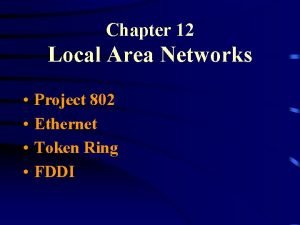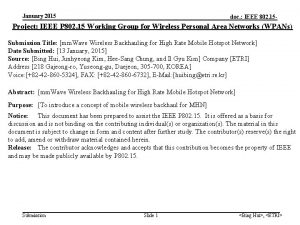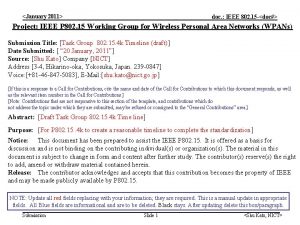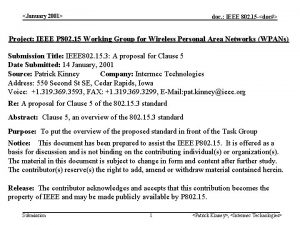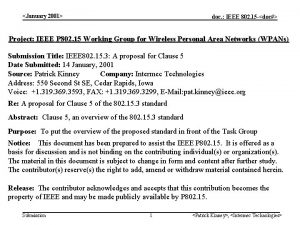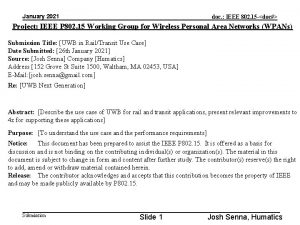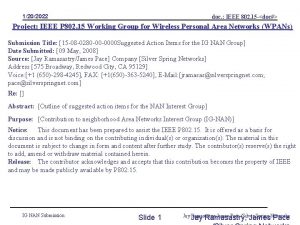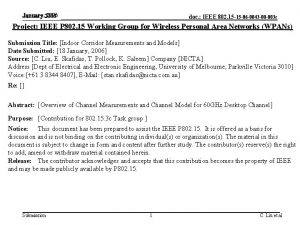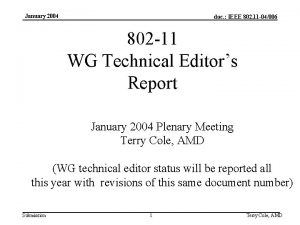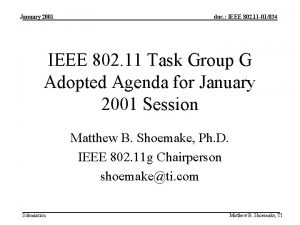January 2020 doc IEEE 802 15 doc Project











- Slides: 11

January 2020 doc. : IEEE 802. 15 -<doc#> Project: IEEE P 802. 15 Working Group for Wireless Personal Area Networks (WPANs) Submission Title: [Proposed Bandwidth Terminology DCN 15 -20 -0038 -01 -ig 6 t] Date Submitted: [14 Jan. 2020] Source: [Menashe Shahar] Company [Ondas Networks] Address [165 Gibraltar Court, Sunnyvale, CA. 95033, USA] Voice: [+1 669 350 -0422], E-Mail: [menashe. Shahar@Ondas. com] Re: [802. 15. 16 t Task Group Procedures] Abstract: [Proposed Bandwidth Terminology for 802. 15. 16 t Task Group. ] Purpose: [To agree on common bandwidth terminology and clarify use thereof] Notice: This document has been prepared to assist the IEEE P 802. 15. It is offered as a basis for discussion and is not binding on the contributing individual(s) or organization(s). The material in this document is subject to change in form and content after further study. The contributor(s) reserve(s) the right to add, amend or withdraw material contained herein. Release: The contributor acknowledges and accepts that this contribution becomes the property of IEEE and may be made publicly available by P 802. 15. Submission Slide 1 Menashe Shahar, Ondas Networks

January 2020 doc. : IEEE 802. 15 -<doc#> Proposed Bandwidth Terminology Menashe Shahar Ondas Networks Submission Slide 2 Menashe Shahar, Ondas Networks

January 2020 doc. : IEEE 802. 15 -<doc#> Table of Contents • • • Bands Channels Blocks Subchannels Sectors Submission Slide 3 Menashe Shahar, Ondas Networks

January 2020 doc. : IEEE 802. 15 -<doc#> Bands • A band is a frequency range between a lowest frequency and a highest frequency. • Three types of bands: – Contiguous – Private Land Mobile Radio (PLMR) – Fragmented Submission Slide 4 Menashe Shahar, Ondas Networks

January 2020 doc. : IEEE 802. 15 -<doc#> Contiguous Band The frequency range between the lowest frequency and the highest frequency is under control of one organization. Submission Slide 5 Menashe Shahar, Ondas Networks

January 2020 doc. : IEEE 802. 15 -<doc#> Private Land Mobile Radio (PLMR) • • • The frequency range between the lowest frequency and the highest frequency is partitioned into multiple fixed bandwidth PLMR channels. The PLMR channels are allocated by the FCC / Spectrum Allocation Authority to multiple organizations. Each of these organizations may be allocated a collection of adjacent or non-adjacent PLMR channels within the band. Submission Slide 6 Menashe Shahar, Ondas Networks

January 2020 doc. : IEEE 802. 15 -<doc#> Fragmented • • • The frequency range between the lowest frequency and the highest frequency includes multiple non-adjacent blocks. The lowest frequency of the band is aligned with the low frequency edge of the lowest frequency block. The highest frequency of the band aligns with the high frequency edge of the highest frequency block. The blocks may be allocated by the FCC / Spectrum Allocation Authority to multiple organizations. Submission Slide 7 Menashe Shahar, Ondas Networks

January 2020 doc. : IEEE 802. 15 -<doc#> Blocks • A relatively small piece of continuous frequency range within a fragmented band • A fragmented band has multiple non-adjacent blocks • Each block may be allocated to a distinct organization • E. g. Automated Maritime Telecommunications System (AMTS) – The AMTS band consists of 1 MHz between 217 and 218 MHz and 1 MHz between 219 and 220 MHz – This should be viewed as 4 blocks of 500 k. Hz wide each Submission Slide 8 Menashe Shahar, Ondas Networks

January 2020 doc. : IEEE 802. 15 -<doc#> PLMR Channels • Typical PLMR channel bandwidth: – 5, 6. 25, 7. 5, 12. 5, 15, 25 and 50 k. Hz. – Most common in the US: 12. 5 k. Hz • Legacy application: PTT voice Submission Slide 9 Menashe Shahar, Ondas Networks

January 2020 doc. : IEEE 802. 15 -<doc#> Partition of Bands into Multiple Subchannels • A band may be partitioned into an integer number of fixed bandwidth subchannels as follows: – Subchannels cover the entire band even if the band is split between multiple organizations. – The edge of the lowest and highest frequency subchannels align with the lowest and highest frequency in the band – In a PLMR band, the edge of the channel is aligned with the edge of the subchannels: • • The subchannel bandwidth may be the same as the PLMR channel bandwidth The PLMR channel bandwidth may be an integer multiple of the subchannel bandwidth – In a fragmented band, the edge of the blocks is aligned with the edge of subchannels. Typically, each block is spanned by multiple subchannels. • Subchannels are a convenient abstract way to characterize a band its usage. A subchannel bitmap may be used to characterize the availability of subchannels to the system as a whole, to each sector within the system and to each remote within the sector. Submission Slide 10 Menashe Shahar, Ondas Networks

January 2020 doc. : IEEE 802. 15 -<doc#> Sectors • A Point to Multipoint system consists of multiple cells each of which consists of multiple sectors • Each sector consists of a base station and multiple remote stations. • The bandwidth available to each sector is a subset of the bandwidth available to the system. This can be easily defined using the subchannel bit map. – Sub-channels not available to the system are also not available to the sector. – Subchannels available to the system may or may not be available to the sector depending on frequency planning designed to meet a self interference goal. • The bandwidth available to each remote is a subset of the bandwidth available to the sector. There may be multiple types of remotes: – A low-end remote may have access to a single subchannel at one time. – A high-end remote may have access to multiple subchannels at one time. Submission Slide 11 Menashe Shahar, Ondas Networks











